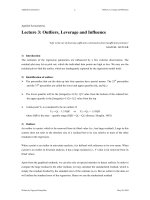Lecture 3 geologic time, sediments, and sedimentary rocks
Bạn đang xem bản rút gọn của tài liệu. Xem và tải ngay bản đầy đủ của tài liệu tại đây (1.84 MB, 37 trang )
Lecture 3 Geologic Time,
Sediments, and Sedimentary
Rocks
CEE 437 Engineering Geology I
Oct. 8, 2002
Sedimentary Rocks and Geologic
Time
• Geologic Time Scale and it Origins
• Sedimentary Rock Types Depositional
Environments
• Engineering Properties
Relative Time
•
•
•
•
•
•
Principle of Superposition
Fossil Evidence
Cross Cutting Relationships
Unconformities
Alteration
Fracture Termination
Geologic Time Scale — Eras
• Precambrian — Minimal fossil record
• Era, Period, Epoch
• Based on major changes — extinctions,
mountain building events
Paleozoic (Old Life) —
Brachiopods, Trilobites, Fish
• Periods based on English Geology
• Cambrian for Latin Wales
• Ordovician and Silurian for ancient Welsh
Tribes
• Devonian for Devon
• Carboniferous for Coal Measures (also
Mississippian and Pennsylvanian in US)
• Permian for Perm Basin in Ukraine
Mesozoic (Middle Life) —
Ammonites, Dinosaurs
• Triassic based on distinctive three-layer
stratigraphy in southern Germany
• Jurassic based on Jura Mountains in France
and Switzerland
• Cretaceous (Latin for Chalk) based on chalk
unit that forms Dover’s cliffs
Cenozoic (Recent Life) —
Mammals, Modern marine fauna
(foraminifera)
• Periods are Tertiary (before Ice Ages) and
Quaternary (ice ages)
• Primary and secondary have been long
replaces
• Rocks of western Washington are primarily
Tertiary and Quaternary in age
Age of the Earth
• Kelvin and a basis in heat flow (set at 20
million years)
• Problem of fitting all of evolution in this
time
• Rutherford and the introduction radioactive
decay
• Added a head source, pushed ages back to
4.5 billion years
Absolute Time
• Basis on radiometric dating Common dating
tools
– 14C, K-Ar, Rb-Sr,Uranium decay series
Sedimentary Rocks
• Clastics, Siliciclastics, Carbonates, and
Evaporites
• Clastic rocks, depositional medium, and
energy
• Diagenesis — chemical changes after
deposition
Clastic Sedimentary Rocks
• Clastic — broken like iconoclast)
• Often referred to as Siliciclastics as having
Si based rock forming minerals
• Based on grain size and to a lesser extent
composition
• Grain size related to energy of depositional
environment
– Relationship of medium velocity to maximum
grain size)
Clastic Sedimentary Rocks
• Clay, muds → shales, mudstones,
claystones (difference based on fissility)
• Silts → siltstones
• Sands → sandstones
• Gravels → Conglomerates (Breccia if
angular, breccia may also be a term for
tectonically fragmented rock)
Weathering Cycle
Clastic Sediments
Classification of Sedimentary
Rocks (ex. evaporites and coal)
Clay Minerals
• Sheets of linked silica tetrahedra sandwiching
octahedral layers of gibbsite composition,
Al2(OH)6, or brucite Mg3(OH)6
• Major Clay Groups
– kaolinite: single gibbsite layer
– montmorillonite:weak water bonding between layers,
moderated by Ca, Na, or K (near-shore environments)
– illite: K bonds between layers (off-shore environments)
– bentonite: highly expansive, volcanic-derived, Na-rich
montmorillonite
Clay Structure
Clay Structure Cont’d.
Kaolinite
Illite
Montmorillonite
Clay Plasticity
Lithification
• Cementation
– deposition of a material different from clasts
• Crystallization
– crystal growth on clasts to fill pore space
• Compaction
• Diagenesis
– Early post-depositional chemical
transformation of sediments, e.g. calcite to
dolomite
Carbonates
• Generally like siliciclastics — carbonate
muds, sands, etc.
• Often deposited in reefs
• Major portion of world oil deposits
• Properties depend strongly on postdepositional pore chemistry
– Cementation
– Dissolution
Carbonate Environments
Evaporites
• Rock salt (NaCl), Gypsum-Anhydrite
(CaSO4), Sylvite (KCl)
• Deposition in regions where evaporation
exceeds recharge
– desert lakes
– restricted seas (Mediterranean)
– lagoons, back-reef areas
• Subject to flow and diapirism









